ASUS N53JF: Midrange 15.6” 1080p, Take Four
by Jarred Walton on December 28, 2010 1:40 AM ESTASUS N53JF: Performs as Expected
Performance is pretty much right where you’d expect, given the hardware. It has the same GT 425M GPU as the Clevo B5130M and the i5-460M CPU is fractionally faster than the i5-450M in the XPS 15, so performance typically falls in between the two. Battery life is somewhat hampered by ASUS’ continued use of 48Wh batteries in their N-series, something we’ve complained about in the past. The U-series’ 84Wh batteries don’t feel much heavier than the 48Wh, and size is close enough that a slight reworking of the N53JF could have accommodated the larger battery. However, ASUS does do a reasonable job at power management, so even with a smaller battery than the competition it remains competitive. Here are the application results, followed by gaming and battery life.
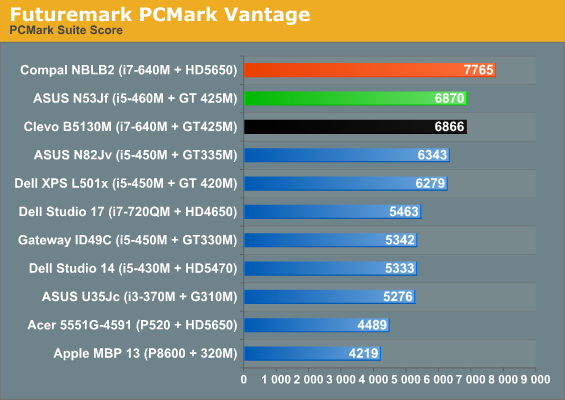
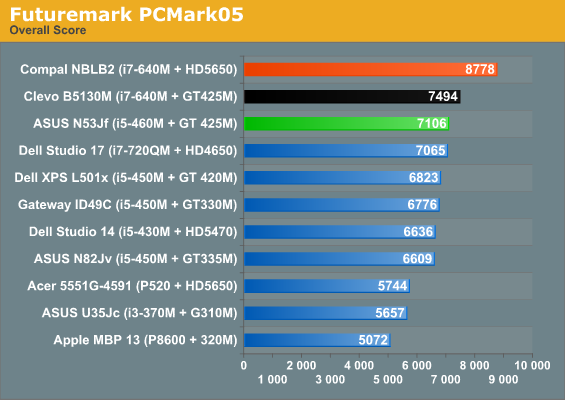
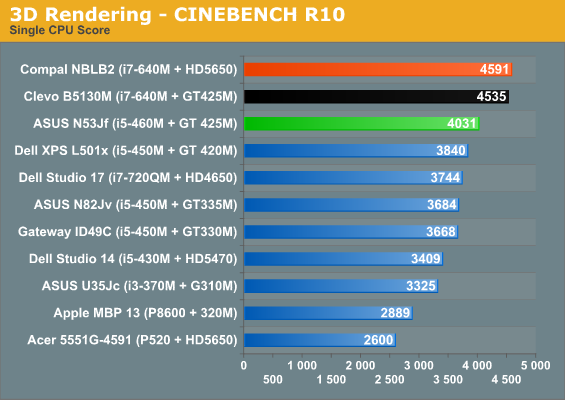
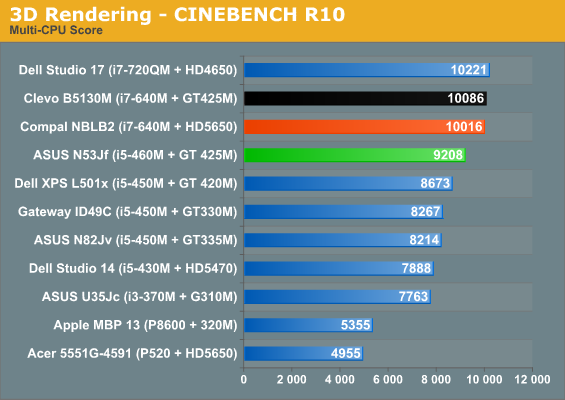
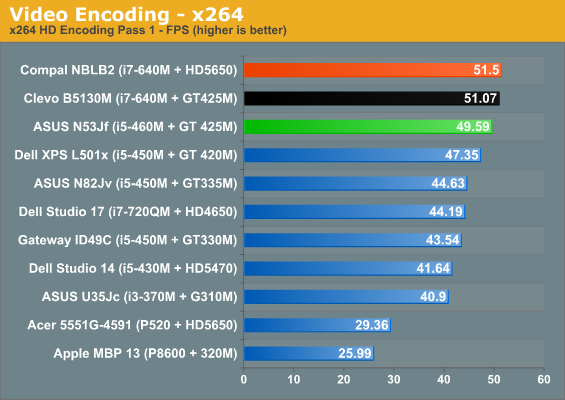

Starting with these general performance metrics, the N53JF is usually about 5% faster (sometimes as much as 10%) than the XPS 15, which goes with the CPU upgrade, with perhaps a few extra performance optimizations by ASUS. The Clevo and Compal laptops both have a faster i7-640M CPU so they come out ahead, but other differences come into play. In PCMark, the Clevo and ASUS laptops are nearly equal, but the Compal comes out 13% faster in Vantage and 23% faster in PCMark05—perhaps thanks to the HD 5650 discrete GPU. Once we hit the pure CPU tests of 3D rendering and video encoding, the charts fall into line and the i7 CPU outpaces the i5-460M by 8-10%.
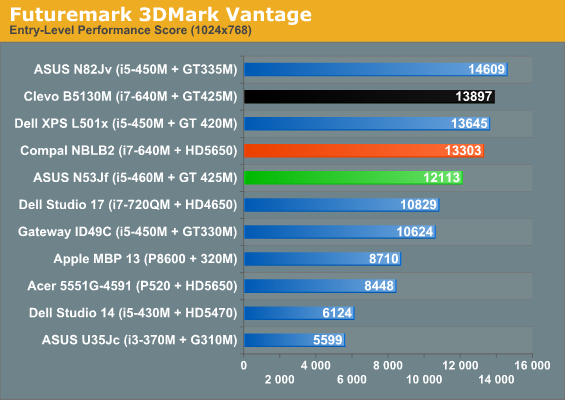
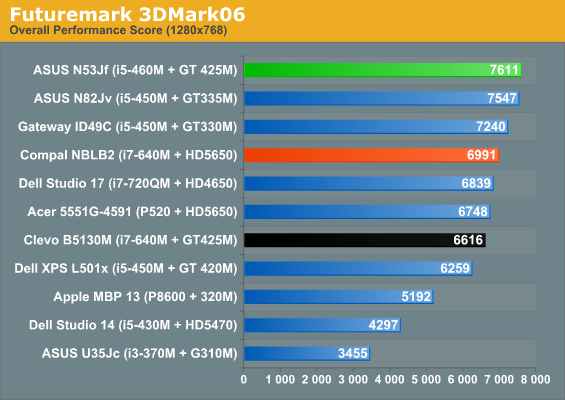
3DMark numbers aren’t a major focus for us, for good reason. Here we see the N53JF leading by up to 22% in 3DMark06, but then it trails by up to 15% in Vantage. Yeah, go figure. The Performance score in Vantage is 3559 for the curious. The 3DMark03/05 numbers aren’t any better (no graphs on those): 16612 in 03 and 13397 in 05 put it slightly ahead of the Clevo and Dell laptops, but the HD 5650 is 3% faster in 05 and 30% faster in 03. The reason for the large lead in 03 is that Optimus appears to be a bottleneck on ultra-high frame rates; the PCIe bus gets saturated, so when you start to try and push more than ~150FPS (i.e. in the Wings of Fury benchmark) you hit a hardware frame rate bottleneck. Given the level of hardware and the frame rates where this manifests, however, it’s nothing we’re concerned about—it should only show up in older titles that really don't stress the GPU much.










65 Comments
View All Comments
visibilityunlimited3 - Wednesday, December 29, 2010 - link
I had problems with my eyes looking at an 14" XGA. I almost went blind before I got my 15.4" Inspiron 1920x1200 screen many years later. My eyes have fewer problems after looking at that high resolution display for many years now.Consider the difference between old dot matrix printers and laser printers. Is reading 1200dpi text uncomfortable? The real problem is Windows being optimized for low res screens. There are a few configuration changes that can help. I actually dual boot with Windows XP and Debian and prefer the Debian for being better equipped to manage the high resolution display. I spent a little extra time fine tuning the X Window System to do exactly what I wanted and I am very comfortable now. I am in no hurry to downgrade to the 1080p display until my old Pentium M gets really tired. The display is that much more important than anything else in my opinion. Thanks Jarred for recognizing the value of the premium displays.
I would like an ebook reader with 1200dpi resolution to match my laser printer and expect that would be very comfortable to use also.
Davelo - Tuesday, December 28, 2010 - link
How many laptops have went bad because of bad BGA solder of Nvidia chips? I've seen so many I would not touch one.DanNeely - Tuesday, December 28, 2010 - link
Weren't those all the first generation lead-free BGA chips? I didn't think any of the newer ones were having problems.JarredWalton - Tuesday, December 28, 2010 - link
Yeah, this is old news. A few anti-NVIDIA sites made a huge deal about the failures, but I never personally had any of those chips fail on me. Of course, I wasn't playing a lot of games on laptops, so maybe that's why. Anyway, anything in the post-8000M era should definitely be fine. Actually, I think it was mostly the old GeForce Go series that had problems.sucram03 - Tuesday, December 28, 2010 - link
Somewhat on & off-topic question: So in all honesty, with such a horrendous screen, where does that leave value-minded users that want a laptop with a nice 1080p screen and a GeForce video card? The application I'm thinking of is CUDA-accelerating H.264/AVC 1080p videos.The XPS 15 isn't listing the B+RG LED as an option, as mentioned in the article. Has anyone else heard from Dell about reasons why/if it will come back? The Clevo seems like an OK option but... well.. it now seems like the only option.
Any thoughts?
JarredWalton - Tuesday, December 28, 2010 - link
At this point, I'd say just wait for the CES announcements and see if anything new turns up. :-)Kaboose - Tuesday, December 28, 2010 - link
Could Dell be holding back the 1080p panels for a sandy laptop in the next few weeks?sucram03 - Tuesday, December 28, 2010 - link
All signs point to yes, especially that suspect smiley face from Jared :) Damn you insider knowledge!Kaboose - Tuesday, December 28, 2010 - link
thank goodness i have been saving up for the past two months in anticipation of sandy bridge and my need for a new portable computer. luckily they coincide.JarredWalton - Tuesday, December 28, 2010 - link
I've got Sandy Bridge, but I have no idea if Dell is holding back panels. I sure hope so...